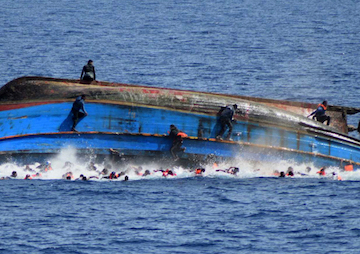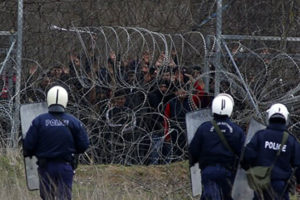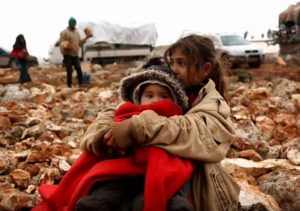Scenes of Horror: More Than 700 Migrants Feared Dead in Three Mediterranean Sinkings
"We found a little kid of a few months," a rescuer said. "Most of them were young people -- we found a [dead] couple hugging each other.”

People try to swim moments after their boat overturned off the Libyan coast. (Italian Navy / AP)
More than 700 people fleeing violence and poverty in Libya are believed to have drowned in the Mediterranean last week in what experts call the deadliest seven days for Europe-bound asylum seekers in more than a year.
Patrick Kingsley reports at The Guardian:
Rescue teams on Sunday described the shocking scenes that confronted them as they responded to the shipwrecks.
“It was pretty gruesome,” said Giorgia Linardi, a member of a rescue team from German NGO Sea Watch, which arrived after an Italian navy ship had started to pull people from the water in Friday’s disaster.
“There were already many dead bodies floating in the sea. Some of them were between life and death because they weren’t reacting, but still breathing.
“Whether they made it, we don’t know, because then we handed them to the Italian warship.”
Many of the bodies were clearly motionless, she said by phone from the middle of the Mediterranean. “We found a little kid of a few months. Most of them were young people – we found a [dead] couple hugging each other.”
The disasters show that despite attempts to crackdown on smugglers in the southern Mediterranean, the flow of migrants between Libya and Italy continues unabated. Roughly the same number of people – 46,000 – arrived in Italy in the first five months of 2016 as during the same period last year.
There are no significant signs that Syrians blocked from entering the EU via the Balkans since March have since shifted route to Libya. At least 26 Syrians were among the survivors last week, but they had been living in Libya for several years, the UNHCR said. Most of the others were escaping dictatorships, wars, and poverty in Eritrea, Nigeria, Somalia and South Sudan.
Since Sea Watch’s boat had limited space, the rescuers would attach fluorescent lifejackets to corpses so that the Italians could find them more easily. But after a while they ran out. “It was quite strange because we usually use the lifejackets to rescue people,” said Linardi.
At one point a net was used to extract people and belongings from the water, she said. “In the net you had hands, heads, feet coming out.”
—Posted by Alexander Reed Kelly.
Your support matters…Independent journalism is under threat and overshadowed by heavily funded mainstream media.
You can help level the playing field. Become a member.
Your tax-deductible contribution keeps us digging beneath the headlines to give you thought-provoking, investigative reporting and analysis that unearths what's really happening- without compromise.
Give today to support our courageous, independent journalists.






You need to be a supporter to comment.
There are currently no responses to this article.
Be the first to respond.